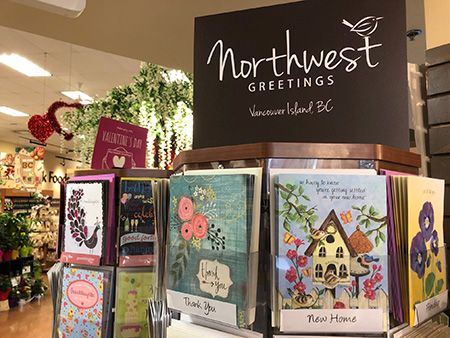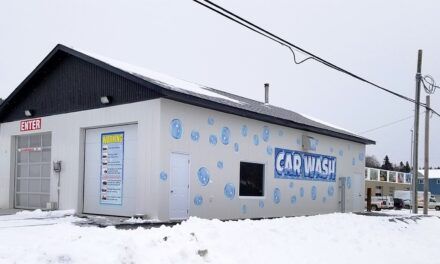
Greeting Card Resurgence Underway

Greeting Card Resurgence Underway
By Angela Altass
The greeting card industry has undergone some really big changes over the last five years but they are still a great fit for convenience stores, says Ron Cumberland, owner, Northwest Greetings.
“I would say that the biggest change has been the introduction of discount cards sold at dollar stores and similar locations,” says Cumberland. “This took a big bite out of traditional card sales but at the same time created an opening for smaller card producers offering more artistic and edgier designs. With this shift, we are seeing card sellers carrying fewer, but higher quality, cards.”
Annual retail sales of greeting cards are estimated between $7 and $8 million, according to the Greeting Card Association. The most popular everyday card-sending occasion is birthday, followed by secondary occasions that include sympathy, thank you, wedding, thinking of you, get well, new baby and congratulations.
As a non-perishable product that takes up relatively little space and carries high margins, greeting cards are attractive to convenience stores, says Cumberland, who advises stores to avoid old-style in-line card displays in favour of spinning floor ones.
“Unless you want to remove all the cards at least a couple times a year to give the card channels a good cleaning, I would go with a spinning floor display,” says Cumberland. “The in-line wall displays are dust collectors. The spinning displays also come with optional castors, which makes moving the display around for repositioning or floor cleaning a breeze.”
Northwest Greetings has been in business for over 25 years and Cumberland says their cards have proven to be a good fit for smaller stores.
“We have tailored our business to meet the needs of smaller, independent retailers that larger companies typically overlook,” says Cumberland. “We offer three lines of cards and work with our customers to select the perfect mix of styles and categories. As an independent distributor, we can offer service terms that are flexible and responsive to the needs of small businesses. For example, new customers are usually surprised when we tell them we have no minimum orders, which I think is a first in our industry.”
Convenience stores tend to be where people will go to purchase a last-minute card, says Audrey Drake, photographer and greeting card designer with Audities Photos and Cards, noting that more variety is available in greeting cards today than ever before.
“My cards are attractive and unique,” says Drake. “I have cards with photos as well as many cards with charming vintage illustrations. They are inexpensive but of very high quality and are very suitable for convenience stores.”
In January, The Schurman Retail Group announced that it was closing all Carlton and Papyrus stores in North America and yet their cards are still available for purchase elsewhere.
“Carlton Cards is the number one greeting card company in Canada,” says Tammy Barrett, director, marketing and trade development, Carlton Cards. “Our products are available in over 6,000 retailer locations nation-wide and will continue to be sold without any interruption at many stores.”
Over the last few years, operators in the greeting card industry have grappled with the advent of paperless substitutes, says the 2019 IBISWorld Inc. market research report Greeting Cards & Other Publishing in Canada. Consumers’ growing use of e-cards, or electronic greeting cards, has constrained demand for traditional greeting cards and postcards, says the report. In response, greeting card publishers, such as Hallmark Canada Inc. and American Greetings Corporation, have offered digital greetings with a monthly or yearly fee for unlimited e-cards.
Northern Cards expanded into e-cards in 1999 but it is not a part of their business today, says Jean-Paul Michael, publisher, Northern Cards.
“We were quite ahead of our time at that point,” recalls Michael. “But, over time, the novelty of that type of communication wore off. For example, I currently have 49,000 unopened e-mails in my in-box. That sounds absurd but it’s the truth. Something handwritten is the novelty now. There’s a sincerity to that and millennials are reconnecting with the authenticity of paper cards and I think that’s where the industry growth is coming from.”
Michael says Northern Cards are a good choice for convenience stores because they give the stores an 85 per cent margin.
“There’s nothing else they are selling that is going to give them that kind of margin,” he states. “We have some distributors but for the large part we are dealing directly with store owners. We have cut out the middle men. The store owners can go onto our website and buy an assortment. The transaction goes through Amazon and it is delivered right to their store. It is a huge switch for us to embrace the new economy and work with Amazon. The advantage is that they get the product to people faster. We had a 13,000-square-foot warehouse and the costs were astronomical compared to the economies of scale that Amazon brings to the table. I know it’s not necessarily the most popular platform with retailers but that’s how we can offer them these margins.”
Peter Doherty, executive director of the Greeting Card Association, feels that the effect on the industry directly coming from e-cards has been somewhat overblown.
“The percentage of cards that are purchased that are considered e-cards is actually quite small,” says Doherty. “It’s hard for electronic media to match the impact of a well-chosen greeting card with just the right message and the right look being received by the recipient at just the right time.”
The last six or seven years has seen an explosion of new material and new content in greeting cards, says Doherty.
“Greetings are all over the map now and are trying to really mirror culture as much as possible,” says Doherty. “Greeting card companies are tackling subjects they never would in the past, but you can also still find the sentimental water colour and flowers card, if that is your style.”

The average age of a greeting card buyer is somewhere in the 30-60-year range, states Doherty.
“If you start thinking about it, millennials are moving into that 30’s timeframe and millennials are actually now buying more cards by dollars than Baby Boomers although Baby Boomers are still buying more in terms of units,” says Doherty. “Millennials are not just purchasing cards, but in many cases, are starting some of the new card companies that are coming out with new innovative lines.”
Some cards are more of a keepsake than just a regular greeting, says Doherty.
Roses Without Thorns products are an example of this souvenir style greeting card.
“My pop-up cards are complex and unique,” explains Link Tong, owner, Roses Without Thorns. “My cards are unconventional and the price range is higher than regular cards. I market them with the intention that they are pieces of art, meant to be kept and displayed. Sometimes, I have limited edition cards with serial numbers on the back; they are collectibles.”
Statistics show that the average American household buys about 30 cards each year, says Tong, who adds that people aren’t just looking for simple cards anymore.
“I have been making cards all of my life,” he says. “In the past five years, I’ve seen many kinds of cards. I’ve seen some cards with seeds inside so you can plant them.”
People are often taking more time to shop around for greeting cards, says Queenie Best, owner, Queenie’s Cards.
“If someone needs a quick birthday or thank you card, a convenience store is the perfect place to pick one up,” notes Best. “I design all of my greeting cards in our Toronto studio. They are printed locally and we also source our envelopes and sleeves in Ontario. Convenience stores are not the target market for a lot of my cards but if a collaboration would give me the opportunity to create new products specifically targeted at convenience stores, that would be fantastic!”
Sharon Krushel, who has made her own cards since she was a child, started DonaBona Cards in 2010 because she wanted to promote Canadian photographers and artists. Krushel says she is open to working with new merchandisers, especially in tourist locations and rural areas as her products have historically sold well in such spots. It is important to have someone who will oversee cards at the store and will keep track of which ones are selling well, she adds.
The greeting card landscape is very competitive, says Maureen Stern, owner, Moki Greetings.
“Right now, the trend is towards smaller cards, generally made with thicker, eco-friendly FSC-certified paper and cute illustrations with messages that connect, inspire and trigger emotional responses,” says Stern. “Overall, the industry has seen a resurgence in demand for traditional paper greeting cards versus digital cards. The reason for that is simple; paper cards are tangible and engage the senses. They trigger our emotions in a memorable and impactful way whereas digital cards are a fluid medium – we may like receiving them in the moment but we forget about them just as quickly. We don’t keep them. We keep paper cards as they symbolize a nostalgic moment.”
For retailers, greeting cards represent an excellent potential revenue stream with very little risk or downside, says Stern, whose cards feature bold, modern illustrations of iconic Canadian characters.
“Greeting cards are easy for the retailer to display and are easy for them to order,” she notes. “Order minimums are generally quite low, making the investment virtually risk-free. Convenience stores could test the market with a few authentically Canadian lines and see how they sell. I’m sure the results would be most favourable.”





































